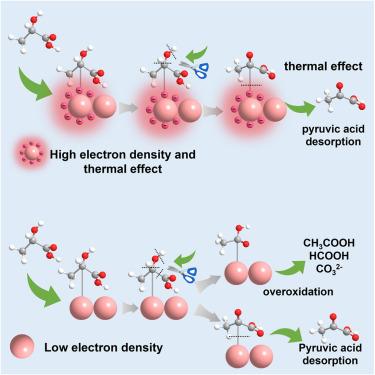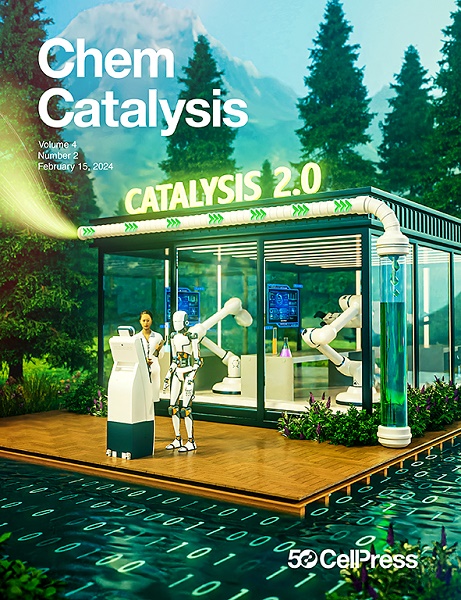Photothermal reforming of polylactic acid plastics into pyruvic acid with 92.8% selectivity at S-scheme Ov-BiVO4/CdS heterostructures
IF 11.6
Q1 CHEMISTRY, PHYSICAL
引用次数: 0
Abstract
Reforming polylactic acid (PLA) into valuable chemicals while producing hydrogen is crucial for a circular economy. However, a significant challenge remains in the limited selectivity of its reformation products. Herein, we report on oxygen vacancy (Ov)-modified S-scheme BiVO4/CdS heterostructures with favorable photothermal effects, aiming to strengthen the Cα−CCOOH bond and activate the α−OH of pretreated PLA for the highly selective production of pyruvic acid (PA). Compared to BiVO4@CdS, Ov-BiVO4/CdS exhibits higher local charge accumulation on Bi sites, which increases the energy barrier of Cα−CCOOH bond cleavage from −0.34 to 0.44 eV and weakens the α−OH bonds in LA simultaneously, thus benefiting the generation of ∗CH3COCOOH intermediates. Moreover, the spontaneous photothermal effect of Ov-BiVO4/CdS induced by Ov promotes the desorption of PA, thereby suppressing its overoxidation. Consequently, the production rate of PA over Ov-BiVO4/CdS reaches 8.92 mmol g−1 h−1 with a selectivity of 92.8%, representing one of the highest selectivity processes reported for plastic reforming.

S-scheme Ov-BiVO4/CdS异质结构下聚乳酸塑料光热重整制丙酮酸的选择性为92.8%
在生产氢气的同时,将聚乳酸(PLA)转化为有价值的化学品对循环经济至关重要。然而,一个重大的挑战仍然是其改革产品的有限选择性。在此,我们报道了氧空位(Ov)修饰的S-scheme BiVO4/CdS异质结构具有良好的光热效应,旨在增强c - α - CCOOH键并激活预处理PLA的α - OH,用于高选择性生产丙酮酸(PA)。与BiVO4@CdS相比,Ov-BiVO4/CdS在Bi位点表现出更高的局部电荷积累,使c - α - ccoh键的能垒从- 0.34 eV增加到0.44 eV,同时减弱了LA中的α - OH键,从而有利于产生∗CH3COCOOH中间体。此外,Ov诱导的Ov- bivo4 /CdS的自发光热效应促进了PA的解吸,从而抑制了PA的过度氧化。因此,在Ov-BiVO4/CdS上,PA的产率达到8.92 mmol g−1 h−1,选择性为92.8%,是目前报道的塑料重整中选择性最高的工艺之一。
本文章由计算机程序翻译,如有差异,请以英文原文为准。
求助全文
约1分钟内获得全文
求助全文
来源期刊
CiteScore
10.50
自引率
6.40%
发文量
0
期刊介绍:
Chem Catalysis is a monthly journal that publishes innovative research on fundamental and applied catalysis, providing a platform for researchers across chemistry, chemical engineering, and related fields. It serves as a premier resource for scientists and engineers in academia and industry, covering heterogeneous, homogeneous, and biocatalysis. Emphasizing transformative methods and technologies, the journal aims to advance understanding, introduce novel catalysts, and connect fundamental insights to real-world applications for societal benefit.

 求助内容:
求助内容: 应助结果提醒方式:
应助结果提醒方式:


